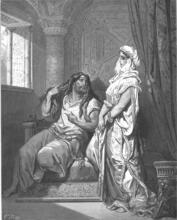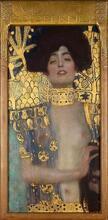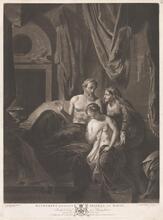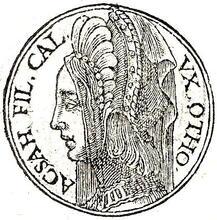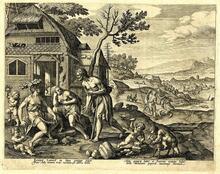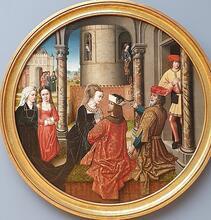Women in Samson's Life: Midrash and Aggadah
Samson’s was involved with three women. The first was a woman from Timnah whom he married. The second woman was a harlot from Gaza, and the third was Delilah, with whom Samson fell in love. In the Midrash, the rabbis debated over when Samson’s sin began. Though some said his marriage to the woman from Timnah initiated his moral decline, others argued that his sinning began when he engaged in sexual activity with a harlot. The rabbis used Samson’s involvement with gentile women as a way to denounce attraction to foreign women and to denounce intermarriage.
The three women in Samson’s life were Gentiles. The first was the woman from Timnah whom he married, the second was the whore from Gaza, and the third was the only woman mentioned by name, Delilah, with whom Samson “fell in love.” According to the Biblical account, Samson’s relations with these women were a means to be revenged upon the Philistines. Nonetheless, the Rabbis use these ties to denounce the attraction to foreign women prevalent at the time.
The Woman from Timnah
One of the views presented in the A type of non-halakhic literary activitiy of the Rabbis for interpreting non-legal material according to special principles of interpretation (hermeneutical rules).midrash is that Samson sinned when he married the Philistine woman from Timnah. The Rabbis learn from the wording of Jud. 14:1: “Once Samson went down to Timnah” that this act was a descent, entailing moral degeneration (BT Suspected adulteressSotah 10a). On their way to Timnah, Samson’s parents saw the vineyards of Timnah, that were planted with kilayim (different species planted together, which is forbidden in Lev. 19:19). They told Samson: “Just as their vineyards are planted with kilayim, their daughters, too, are the result of intermingling,” thinking that in this manner they would convince him not to marry a Philistine woman. In this context the Rabbis mention that “You shall not intermarry with them” is written in seven places in the Torah she-bi-khetav: Lit. "the written Torah." The Bible; the Pentateuch; Tanakh (the Pentateuch, Prophets and Hagiographia)Torah, in order to forbid intermarriage with all the seven nations that inhabited Canaan, including the Philistines (Num. Rabbah 9:24). Samson, however, did not heed his parents, preferring instead what his eyes saw (Jud. 14:3): “But Samson answered his father, ‘Get me that one, for she is the one that pleases me’ [literally, is right in my eyes]”; he was punished accordingly (middah ke-neged middah: “measure for measure”) when the Philistines gouged out his eyes, as is portrayed in Jud. 16:21 (M Sotah 1:8).
The Rabbis question this approach, since the Bible states explicitly: “this was the Lord’s doing: He was seeking a pretext against the Philistines” (Jud. 14:4). According to this verse, Samson’s marriage to the woman from Timnah was part of the divine plan to take revenge on the Philistines for their dominating and harassing of Israel; why, then, did Samson have to be punished for this? The Lit. "teaching," "study," or "learning." A compilation of the commentary and discussions of the amora'im on the Mishnah. When not specified, "Talmud" refers to the Babylonian Talmud.Talmud answers this question with the folk saying: “At any rate, when he went, he followed his own inclinations.” Samson did not marry the woman from Timnah for Heaven’s sake, but out of his own proclivity for foreign women. This weakness would reveal itself again in his liaisons with the woman from Gaza and with Delilah, and he consequently was punished even for the first relationship, which was a formal marriage, because of this proclivity (BT Sotah 9b).
The Woman from Gaza
According to another view, Samson did not sin with the woman from Timnah, for he took her for the purpose of matrimony. His moral decline began with the woman from Gaza, when he merely engaged in intercourse with a harlot. The Rabbis find this, as well, to be an instance of middah ke-neged middah. Since this illegitimate act took place in Gaza (Jud. 16:1: “Once Samson went to Gaza”), in punishment, the Philistines seized him and, as v. 21 relates, “brought him down to Gaza” (BT Sotah loc. cit; Num. Rabbah 9:24).
The Rabbis also learn of Samson’s many liaisons with foreign women from his end. When Samson was imprisoned in Gaza he was a “mill slave [tohen] in the prison” (Jud. 16:21). The Rabbis understand the word “tohen” as meaning sin, specifically sexual misdoing, which they deduce from Job 31:10: “May my wife grind [tithan] for another, may others kneel over her!” Each of the Philistines would bring his wife to Samson’s prison, that he might impregnate her, so that they would have a child as strong and powerful as Samson. In this vein, the Rabbis cite the popular saying: “Before a wine drinker, set wine, before a plowman, set a basket of roots.” Since Samson was such a womanizer, they brought women to him (BT Sotah 10a). With these statements the Rabbis might mean to demonstrate, once again, that Samson’s beginnings determined his end and that his punishment fit the crime.
For the Rabbis’ attitude to Delilah, see “Delilah.”


